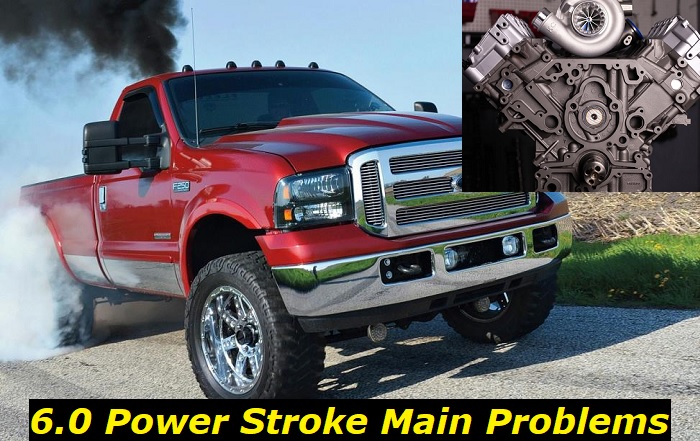The Power Stroke is an engine produced by Navistar from 1994 to 2010 and was continued by Ford from 2011 to the present. It's primarily used in heavy-duty trucks. Due to its high level of utility coupled with excellent performance, it enjoyed a huge following from customers, and it remains one of the top choices for engines in vehicles worldwide. However, it wasn't without its share of bad consumer reports and reviews over the years. One infamous version of the engine was the 6.0L Power Stroke.
The 6.0L Power Stroke came out as a successor to the more beloved 7.3L Power Stroke. The production run of the engine went from 2003 to 2007. It should be noted that the 6.0L was made to replace the 7.3L version in compliance with the stringent diesel emission standards that became effective in 2003.
The engine is powered by diesel and is designed with a turbocharger and V8 layout. It has a displacement of 5,967 cc, a bore of 3.74 inches, a stroke of 4.13 inches, and a compression ratio of 18.0:1.

Key features and my opinion about the engine
- Production years:2003-2009
- Average lifespan of 6.0L Power Stroke:320,000-350,000 miles
- Fuel supply type:direct injection
- Power range:325 hp
- Fuel efficiency:bad
- Engine block material:cast-iron
- Engine reliability score:low
- The most common problems:EGR cooler and oil cooler problems, fuel pump issues, head gasket problems, oil pump failing.
Key Issues by Year Model
If you're considering purchasing a vehicle with the 6.0L Power Stroke diesel engine, it's important to be aware of the potential problems and solutions for them. This article will provide an overview of the most common issues reported by customers, which include the following:
- High-pressure oil pump leak in 2005 models
- Sticking vanes in variable-geometry turbochargers (VGT) in 2005 models
- Turbocharger failure from 2003 to 2005 models
- Clogged oil cooler from 2004 to 2007 models
- EGR cooler design flaw from 2004 to 2007 models
- Oil leak in oil rail plugs from 2005 to 2007 models
- Blown head gasket from 2003 to 2007 models
- Sticking spool valve in the injector from 2003 to 2007 models
- Coolant leakage from 2003 to 2007 models
- Fuel Injection Control Module (FICM) malfunction from 2003 to 2007 models
Read on to know what each of these problems can potentially do to your vehicle as well as what causes each and the immediate solutions that you can apply to fix the issue.
1. High-pressure oil pump leak
The high-pressure oil pump is responsible for supplying oil at high pressure to the engine. A leak in this component can result in a number of problems, including loss of power, engine failure, and even a fire. The most common cause of high-pressure oil pump leaks is a failed seal.
This is a problem commonly experienced by the 2005 models of the 6.0L Power Stroke. To fix this, the seal needs to be replaced. If the pump has already failed, the entire pump will need to be replaced.
2. Sticking vanes in variable-geometry turbochargers (VGT)
The 6.0L Power Stroke diesel engine is known for having problems with its variable-geometry turbochargers (VGTs) in 2005. One of the most common issues is that the vanes inside the VGT can become stuck, which can result in a loss of power and engine failure.
There are several things that can cause the vanes to stick, including dirt and carbon buildup, corrosion, and oil leaks. If your VGT is sticking, the best solution is to replace it.
3. Turbocharger failure
One of the most common problems with the 6.0L Power Stroke diesel engine from 2003 to 2005 models is turbocharger failure. This can occur for several reasons, including dirt and carbon buildup, oil leaks, and corrosion.
If your turbocharger fails, the best solution is to replace it. However, if the turbocharger is still functioning but the oil drain tube is clogged, you can try cleaning it out. To do this, remove the oil drain tube and use a brush or a pipe cleaner to clean out the inside.
4. Clogged oil cooler
The oil cooler is a component of the cooling system that helps maintain the temperature of the engine. A common problem with the 6.0L Power Stroke diesel engine is that the oil cooler can become clogged from its 2004 to 2007 models. This can make the engine overheat and lose its functions.
There are several things that can cause the oil cooler to become clogged, including dirt and carbon buildup, corrosion, and a blocked oil drain hole. If your oil cooler is clogged, the best solution is to clean it out. To do this, remove the oil cooler and use a brush or a pipe cleaner to clean out the inside.
5. EGR cooler design flaw
The 6.0L Power Stroke diesel engine from 2004 to 2007 models is known for having a design flaw with its exhaust gas recirculation (EGR) cooler. This can cause the engine to heat up and stop functioning.
The EGR cooler is a component of the emissions system that helps reduce emissions by recirculating exhaust gases back into the engine. A common problem with the 6.0L Power Stroke diesel engine is that the EGR cooler can become clogged, which can cause the engine to overheat and fail.
There are several things that can cause the EGR cooler to become clogged, including dirt and carbon buildup, corrosion, and a blocked oil drain hole. If your EGR cooler is clogged, the best solution is to clean it out. To do this, remove the EGR cooler and use a brush or a pipe cleaner to clean out the inside. A more convenient solution would be to simply replace it.
6. Oil leak in oil rail plugs
Oil leaks in the oil rail plugs are a common problem with the 6.0L Power Stroke diesel engine from 2005 to 2007 models. This can cause the engine to lose power and stop operating.
The best solution for this problem is to replace the oil rail plugs. You can do this by removing the intake manifold and replacing the plugs.
7. Blown head gasket
A blown head gasket is a common problem with the 6.0L Power Stroke diesel engine from 2004 to 2007 models. This can cause the engine to lose power and fail.
The best solution for this problem is to replace the head gasket.
8. Sticking spool valve in the injector
There are several things that can cause the valves to stick in open or closed state like contamination from foreign particles, sludge build-up, or mechanical problems stemming from broken components (i.e. springs, washers, pins, etc.). In the case of defective components, just find a replacement for them. Another solution is via an inductive heating flash in the FICM if the injector components appear to be okay yet they are not functioning correctly.
9. Coolant leakage
One of the most common problems with the 6.0L Power Stroke diesel engine from 2003 to 2005 models is coolant leakage. This can occur for a number of reasons, including cracks in the cylinder head, a failed head gasket, and a failed water pump.
If your engine is leaking coolant, the best solution is to repair or replace the defective component.
10. Fuel Injection Control Module (FICM) malfunction
The 6.0L Power Stroke diesel engine is known for having problems with its Fuel Injection Control Module (FICM) in 2005. One of the most common issues is that the FICM can malfunction and cause engine failure and power loss.
Several things can cause the FICM to malfunction, including a failed power module, a failed voltage regulator, or a failed sensor. If your FICM keeps on malfunctioning, the best solution is to re-flash or replace it.
Conclusion and Recommendation
The 6.0L Power Stroke has an amazing pedigree as a successor to the 7.3L Power Stroke, promising great performance and reliability to buyers. But after a while, bad reviews started coming out from consumers who were using it on their daily drives. The most common of which are the problems listed here.
The issues indicated here, if ignored, can result in engine malfunction such as overheating, loss of power, and even fire. Therefore, it is important to know the first aid solutions you can apply to them using the guide here.
If the problems persist after applying the best possible solutions mentioned here, they may already be a part of a more complex issue that needs more skilled hands. That may be a sign to bring it to your trusted mechanic or service center for further diagnosis and repairs.
About the authors
The CarAraC research team is composed of seasoned auto mechanics and automotive industry professionals, including individuals with advanced degrees and certifications in their field. Our team members boast prestigious credentials, reflecting their extensive knowledge and skills. These qualifications include: IMI: Institute of the Motor Industry, ASE-Certified Master Automobile Technicians; Coventry University, Graduate of MA in Automotive Journalism; Politecnico di Torino, Italy, MS Automotive Engineering; Ss. Cyril and Methodius University in Skopje, Mechanical University in Skopje; TOC Automotive College; DHA Suffa University, Department of Mechanical Engineering






Add comment